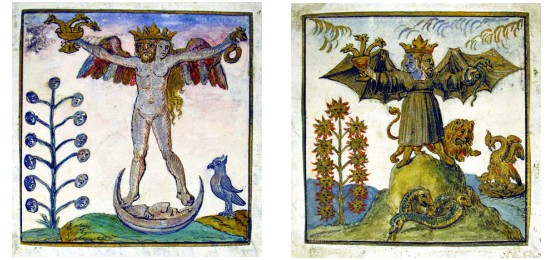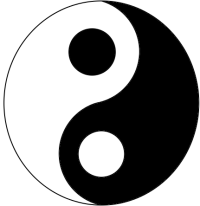Hsu Yun refers to the spiritual transformation we call divine marriage, the unification of sexual opposites within ourselves, the mystics’ state of androgyny. In Jungian terms, it is the integration of anima and animus within our psyche that manifests as androgyny. In Buddhism, this is an advanced state which is attained after one has entered the deepest state of meditation, called Samadhi.
For P. K., J. M., M.L., and K.S.
Divine love -- timeless, eternal, beyond life and death. Jalaluddin Rumi expressed it like this:
Love is from the infinite, and will remain until eternity.
The seeker of love escapes the chains of birth and death.
Tomorrow, when resurrection comes, The heart that is not in love will fail the test.
- From Thief of Sleep, by Shahram Shiva
Such exalted expressions of spiritual love are not unique to Islam. Chan master Hsu Yun wrote in his famous ox herding poems:
7. Keeping the Person Because of the Ox
I went from the city to the edge of the sea
I returned riding backwards in a white ox wagon.
Into this painted hall comes a spinning red wheel.
The New Bride finally arrives, and from my own house!
Hsu Yun refers, here, to the spiritual transformation we call divine union, or the unification of sexual opposites within ourselves; the mystics’ state of androgyny, arising from Ancient alchemical depictions of the union of male and female, also referred to as divine marriage or divine union. the integration of anima and animus. In Buddhism, this androgynous state is attained after one has entered the deepest state of meditation, Samadhi. Yet not all people who attain Samadhi experience androgyny. Just as satori requires that we give up attachment to the ego-self and all that has gone into creating it, androgyny requires that we go further and give up our sexual identity, perhaps the strongest attachment that exists within the psyche, regardless of whether we are heterosexual or identify as LGBTQ+. Ortigue and others performed experiments that show that sexual-love engages especially those parts of the brain utilized for social cognition and bodily self-representation[FN-1], implying that sexuality could be at the very root of self-identification. For the mystic, the androgynous state represents the pinnacle of Self-integration, Self-awareness and individuation.
Ancient alchemical depictions of the union of male and female, also referred to as divine marriage or divine union. the integration of anima and animus. In Buddhism, this androgynous state is attained after one has entered the deepest state of meditation, Samadhi. Yet not all people who attain Samadhi experience androgyny. Just as satori requires that we give up attachment to the ego-self and all that has gone into creating it, androgyny requires that we go further and give up our sexual identity, perhaps the strongest attachment that exists within the psyche, regardless of whether we are heterosexual or identify as LGBTQ+. Ortigue and others performed experiments that show that sexual-love engages especially those parts of the brain utilized for social cognition and bodily self-representation[FN-1], implying that sexuality could be at the very root of self-identification. For the mystic, the androgynous state represents the pinnacle of Self-integration, Self-awareness and individuation.
What are the consequences of not integrating the anima and animus, our female and male elements, within each of us? Until these forces are conscious they will seek to become known by influencing us according to their whims. A man under the unconscious influence of an inflamed anima may find himself moody, experience easily-hurt feelings, and have a grandiose sense of self-importance. A woman under the unconscious influence of an inflamed animus may be highly opinionated, ruthless, harsh, unyielding, and act, in general, in an outwardly destructive manner. When the unconscious element is pacified, the effects are opposite. A man will show compassion, patience, kindness and warmth; a woman will show thoughtfulness and control and psychological strength.
In our social lives, the anima, or animus, is easily unleashed upon others through an act of projection. We may become enraged at others, or we may “fall in love” in a furious heat. Apart from the emotions which guide our primitive fight-or-flight survival instincts, the emotions which lead to the continuation of our species are perhaps the strongest of them all and influence us in many ways. When a man sees a woman who he finds attractive and potentially available, the process of projection begins, a complex sequence of unconscious events in which he identifies the woman with the ideal form of his anima. The woman thus becomes a worldly manifestation of his internal anima complex. Thus idealized, the woman is raised upon a golden pedestal, her human qualities replaced by projected elements of the ideal form. The man feels elated and sexually aroused. Similar events take place in the mind and psyche of the woman, with the exception that her projection is of the animus rather than the anima. For people who identify as LGBTQ+, the anima and animus can be reversed or airse in vaious proportions.
Of course the anima and animus are only real in the sense that the terms describe certain types of feelings and patterns of behavior. Ultimately, all our experiences are driven by the complexities of brain chemistry which, while different for each person, have many commonalities when we look at evolution’s solution to the survival and reproduction of our species. The terms we use to describe these things exist within a paradigm, or model, that allows us to make connections and better understand our behaviors.
The animus (or anima) has no other purpose, evolutionarily speaking, than continuing our species through procreation. Yet there are some real psychological dangers we need to be aware of when engaged in such projection. Projection leads to a perceived dependence on the person who is projected upon, as that person now occupies the status of a “super person,” an ideal form. As a result, our identity becomes intertwined with him (or her). We may then become subjected to a roller-coaster ride of emotional highs and lows. The fear of rejection can be terrifying since the connection is really between us and our anima/animus, not between us and the other person. The fear of losing the anima is a fear of losing a part of one’s self, one’s identity. It’s not surprising that, among the most disconnected people, traumatic acts of violence and vengeance are not uncommon. And it’s not surprising that marriages taking place between couples during this projection-phase often don't last. Once there is no more projection, usually within a year or two, the couple may find that they have little in common, or worse, don’t like each other’s company. To see another person as they truely are requires a complete lack of projection.
 The ubiquitous symbol from taoism represents the spinning union of male and female elements, light and dark, yin and yang.Wherever we happen to be on life’s journey, it’s valuable to be aware of this complex dynamic of forces that so strongly influences our lives and the lives of those around us. With acute observation, we can learn more about ourselves when we fall under their influence. We can also better understand the behaviors of others. How does this relate to Zen? Through knowledge and understanding we can modify our behavior in ways that support our well-being and lead to an enhanced awareness of Self, in accordance with the first four steps of the Eightfold Path: Right Understanding, Right Thought, Right Speech, and Right Action. As we become progressively more adept at delving within, we may eventually transcend our sexual identities as they merge into the bliss of divine union.
The ubiquitous symbol from taoism represents the spinning union of male and female elements, light and dark, yin and yang.Wherever we happen to be on life’s journey, it’s valuable to be aware of this complex dynamic of forces that so strongly influences our lives and the lives of those around us. With acute observation, we can learn more about ourselves when we fall under their influence. We can also better understand the behaviors of others. How does this relate to Zen? Through knowledge and understanding we can modify our behavior in ways that support our well-being and lead to an enhanced awareness of Self, in accordance with the first four steps of the Eightfold Path: Right Understanding, Right Thought, Right Speech, and Right Action. As we become progressively more adept at delving within, we may eventually transcend our sexual identities as they merge into the bliss of divine union.
For more information about Androgeny, see the following books:
Androgyny: The Opposites Within, by June Singer
The Androgyne, Reconciliation of Male and Female, by Elemire Zolla
For more information about Jungian psychology and its relevance to Chan, see the following books:
An Introduction to Zen Buddhism by D. T. Suzuki and Carl Jung
Self and Liberation: The Jung-Buddhism Dialogue by Daniel J. Meckel and Robert L. Moore
FN-1) Ortigue S, Bianchi-Demicheli F, Patel N, Frum C, Lewis JW. Neuroimaging of love: fMRI meta-analysis evidence toward new perspectives in sexual medicine. J Sex Med. 2010 Nov;7(11):3541-52. doi: 10.1111/j.1743-6109.2010.01999.x. Epub 2010 Aug 30. Review. PubMed PMID: 20807326.
